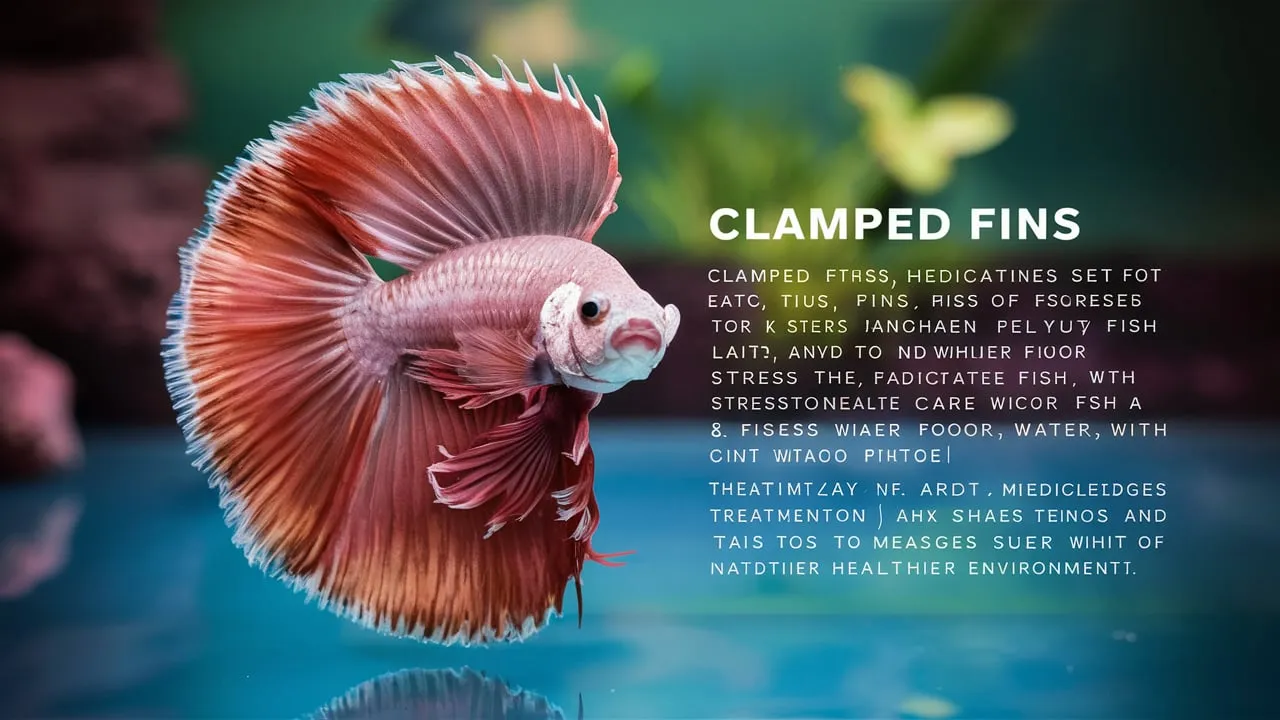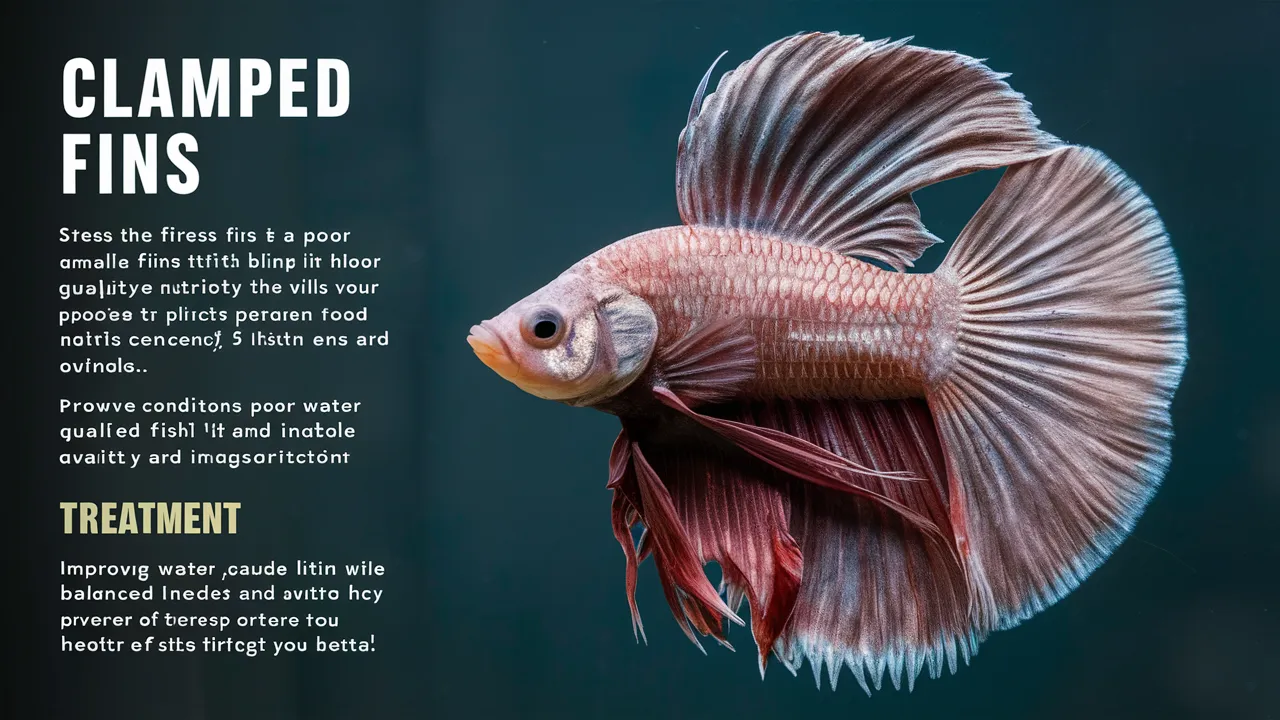Clamped Fins On Betta fish are a common concern among aquarium enthusiasts.
This Betta Fish Guide will explore the causes, treatments, and prevention methods for clamped fins in betta fish, providing you with the knowledge to ensure your aquatic companion thrives.
Understanding Clamped Fins in Betta Fish
What are clamped fins?
Clamped fins refer to a condition where a betta fish’s fins are held close to its body, appearing contracted or folded. This is a sign of distress and often indicates an underlying health issue.
Normal fin appearance vs. clamped fins
In healthy bettas, fins are typically extended and flowing, adding to their graceful appearance. Clamped fins, on the other hand, are held close to the body, appearing stiff and unnatural. They may also appear ragged or frayed.
The impact of clamped fins on betta health
Clamped fins can have a significant impact on a betta’s health and well-being. They can hinder swimming ability, making it difficult for the fish to navigate its environment. Clamped fins are also more susceptible to injury and infection, as they are not able to protect the fish’s body as effectively.
Common Causes of Clamped Fins On Betta
Understanding the root causes of clamped fins is crucial for effective treatment and prevention. Let’s explore the most common reasons:
Poor Water Quality
One of the primary causes of clamped fins in betta fish is poor water quality. Bettas are sensitive to their environment, and suboptimal water conditions can quickly lead to stress and health issues.
Key Water Parameters for Betta Fish:
- Temperature: 76-82°F (24-28°C)
- pH: 6.5-7.5
- Ammonia: 0 ppm
- Nitrite: 0 ppm
- Nitrate: <20 ppm
Bacterial or Parasitic Infections
Infections can cause significant discomfort for your betta, leading to clamped fins. Common culprits include:
- Fin rot
- Ich (White Spot Disease)
- Velvet Disease
Stress Factors
Bettas are sensitive creatures, and various stressors can lead to clamped fins:
- Overcrowding
- Aggressive tank mates
- Sudden changes in environment
- Excessive handling
Nutritional Deficiencies
A poor diet lacking essential nutrients can weaken your betta’s immune system and lead to various health issues, including clamped fins.
Genetic Factors
In some cases, clamped fins may be a result of genetic predisposition or inbreeding. However, this is less common than environmental or health-related causes.

Diagnosing Clamped Fins
- Visual signs and symptoms
Observing the betta’s fins for signs of clamping, such as stiffness, folding, or ragged edges, is the first step in diagnosis.
- Behavioral changes in affected bettas
Clamped fins can be accompanied by behavioral changes like lethargy, loss of appetite, hiding, or increased respiration.
- Water testing and parameter analysis
Testing the water for ammonia, nitrite, nitrate, pH, and temperature can help identify environmental factors contributing to the clamped fins.
Identifying Clamped Fins in Betta Fish
Early detection is key to successful treatment. Here are signs to watch for:
- Fins held close to the body
- Reduced swimming activity
- Loss of vibrant coloration
- Refusal to eat
- Hiding behavior
Treatment Options for Clamped Fins
Once you’ve identified clamped fins in your betta, it’s time to take action. Here’s a step-by-step approach to treating this condition:
Water Quality Assessment
The first step in treating clamped fins is to check and improve water quality:
- Perform a 25-30% water change
- Test water parameters and adjust as necessary
- Ensure proper filtration and aeration
Isolation and Quarantine
If you suspect an infection, isolate your betta in a quarantine tank to prevent spread and facilitate treatment.
Medication and Treatment
Depending on the underlying cause, you may need to administer medication:
- For bacterial infections: Use appropriate antibiotics like Erythromycin or Kanamycin
- For parasitic infections: Utilize treatments such as Ich-X or Copper-based medications
- For fungal infections: Apply antifungal treatments like Methylene Blue
Always follow dosage instructions carefully and complete the full course of treatment.
Stress Reduction
Minimize stress for your betta during recovery:
- Maintain a quiet environment
- Provide hiding spots with plants or decorations
- Dim aquarium lights
Nutritional Support
Offer a varied, high-quality diet to boost your betta’s immune system:
- Live or frozen foods like bloodworms or brine shrimp
- High-quality betta pellets or flakes
- Supplements rich in vitamins and omega-3 fatty acids

Preventing Clamped Fins in Betta Fish
Prevention is always better than cure. Here are some tips to keep your betta’s fins healthy and flowing:
Maintain Optimal Water Conditions
- Regular water changes (20-30% weekly)
- Consistent water parameter monitoring
- Proper filtration system
Provide a Suitable Habitat
- Minimum 5-gallon tank for a single betta
- Gentle water flow
- Adequate hiding spots and resting areas
Balanced Diet
- Variety of high-quality foods
- Feeding schedule (2-3 small meals daily)
- Avoid overfeeding
Regular Health Checks
- Daily observation of behavior and appearance
- Weekly fin inspections
- Prompt action on any signs of illness
Stress Management
- Careful selection of tank mates (if any)
- Gradual acclimation to new environments
- Minimal handling
Conclusion
Clamped Fins On Betta fish are a clear signal that your aquatic friend needs attention. By understanding the causes, recognizing the symptoms early, and taking prompt action, you can help your betta recover and prevent future occurrences. Remember, a healthy betta is a happy betta, and with proper care, your finned friend can thrive and display its beautiful, flowing fins with pride.

Related Posts
Culture Of Infusoria In The Tank: A Microscopic Feast for Fry
Almond Leaf For Betta: A Natural Habitat Enhancer
Pregnant Betta Fish Giving Birth: Signs & How To Care